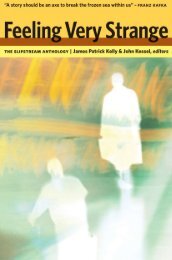The Curse of the Wer.. - Site de Thomas - Free
The Curse of the Wer.. - Site de Thomas - Free
The Curse of the Wer.. - Site de Thomas - Free
Create successful ePaper yourself
Turn your PDF publications into a flip-book with our unique Google optimized e-Paper software.
14 THE CURSE OF THE WEREWOLF<br />
In <strong>the</strong> nineteenth century, new accounts <strong>of</strong> lycanthropy were<br />
<strong>de</strong>veloped by antiquarians, folklorists, mythologists, historians and<br />
o<strong>the</strong>r social commentators. As David Punter has argued, <strong>the</strong> resurrection<br />
<strong>of</strong> such subject matter was linked with <strong>the</strong> emergence <strong>of</strong><br />
mo<strong>de</strong>rnity; ‘vampires are <strong>the</strong> most obvious case in point: <strong>the</strong> legendry<br />
itself is age-old, and even in British literature <strong>the</strong>re are plenty <strong>of</strong><br />
preromantic allusions, but only in <strong>the</strong> early nineteenth century was<br />
vampirism brought into alignment with more mo<strong>de</strong>rn anxieties.’ 9 Like<br />
<strong>the</strong> vampire, <strong>the</strong> werewolf was re-created as a mo<strong>de</strong>rn monster in<br />
nineteenth-century texts. Interest in lycanthropy was reignited early<br />
in <strong>the</strong> century, in <strong>the</strong> context <strong>of</strong> romanticism, when <strong>the</strong> backlash<br />
against Enlightenment principles was well un<strong>de</strong>r way and <strong>the</strong> Gothic<br />
novels <strong>of</strong> Horace Walpole, Ann Radcliffe and Mat<strong>the</strong>w ‘Monk’ Lewis<br />
had already proved popular.<br />
In contrast to <strong>the</strong> philosophers <strong>of</strong> <strong>the</strong> Enlightenment who had sought<br />
to eradicate superstition, <strong>the</strong> romantics embraced it as a source <strong>of</strong><br />
poetic inspiration. <strong>The</strong> <strong>de</strong>velopment <strong>of</strong> <strong>the</strong> Gothic mo<strong>de</strong> during <strong>the</strong><br />
romantic period is one <strong>of</strong> <strong>the</strong> more obvious indications <strong>of</strong> this ten<strong>de</strong>ncy.<br />
Tobin Siebers accounts for <strong>the</strong> difference between Enlightenment and<br />
romantic attitu<strong>de</strong>s to superstition historically, writing that <strong>the</strong> Enlightenment<br />
philosophers’ ‘aversion to superstition came from [<strong>the</strong>ir]<br />
exposure to it’, whereas ‘[t]he Romantics associated superstition and<br />
poetry because <strong>the</strong>ir distance from magical thought allowed <strong>the</strong>m to<br />
transform it into an aes<strong>the</strong>tic formula.’ 10 A passage in Charles Maturin’s<br />
Gothic novel <strong>The</strong> Albigenses (1824) — in which <strong>the</strong> werewolf ma<strong>de</strong><br />
its first appearance in <strong>the</strong> nineteenth century — supports Siebers’s<br />
point. A knight is incarcerated in a dungeon with a lycanthrope as<br />
his cell-mate.<br />
It was evi<strong>de</strong>ntly a man in <strong>the</strong> most horrid paroxysm <strong>of</strong> lycanthropy, a<br />
distemper now unknown, but well au<strong>the</strong>nticated to have existed at a far<br />
later period than that <strong>of</strong> our tale. ‘Examine me,’ said <strong>the</strong> unhappy wretch;<br />
‘I tell <strong>the</strong>e I am a wolf. Trust not my human skin — <strong>the</strong> hairs grow inward,*<br />
and I am a wolf within — a man outward only’.<br />
* This <strong>de</strong>claration was actually ma<strong>de</strong> by an unhappy wretch in <strong>the</strong> most rabid, but still<br />
conscious stage <strong>of</strong> <strong>the</strong> disease. 11





